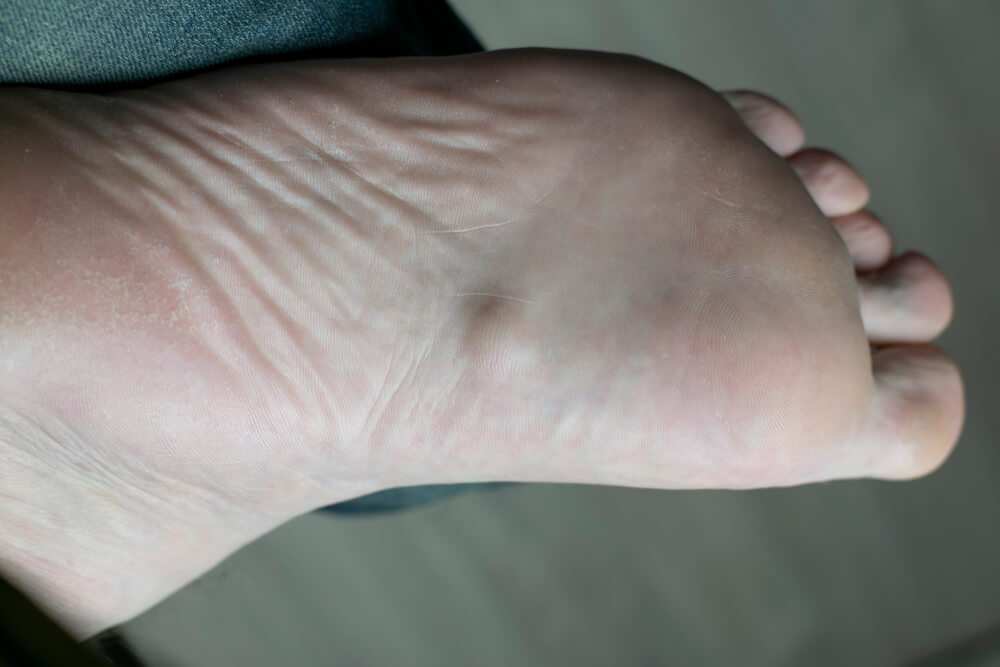Plantar Fibroma: Causes, Symptoms & Treatment
A plantar fibroma is a benign growth that appears as a lump or nodule on the arch or bottom of the foot. It is a type of plantar fascia disorder known as plantar fibromatosis. This condition results from the overgrowth of fibrous tissue in the arch of the foot. This article will explore the causes, symptoms, and various treatment options for plantar fibromas.
What is a Plantar Fibroma?
Plantar fibromas are benign, fibrous knot that grows on the plantar fascia, which is the tissue that runs along the bottom of the foot. The plantar fascia supports the arch of the foot; when damaged, it can cause pain and discomfort. Plantar fibromas usually appear in the mid-arch or the ball of the foot and are usually less than an inch in size. They are usually firm and can cause pain when pressure is applied.
Plantar Fibroma Causes
While the exact cause of plantar fibroma is unknown, several factors may contribute to its development. These factors include:
Genetic Factors
Plantar fibromas have been linked to genetic factors, and individuals with a family history of this condition may be more likely to develop it. Some research has suggested that a genetic mutation may lead to the overproduction of fibrous tissue in the plantar fascia, leading to the formation of a fibroma.
Environmental Factors
While genetics play a significant role in the development of plantar fibroma, environmental factors may also play a role. For example, individuals who have experienced trauma or injury to the foot may be more likely to develop plantar fibromas. Repetitive stress and pressure on the plantar fascia, such as from high-impact sports or standing for extended periods, may also form a fibroma.
Related Foot Conditions
Plantar fibroma is part of a group of conditions known as plantar fascia disorders. These conditions are related to the plantar fascia, a thick band of tissue that runs along the bottom of the foot. Conditions such as plantar fasciitis, plantar fascia tears, and flat feet can all increase the risk of developing a plantar fibroma.
Risk Factors for Plantar Fibroma
- Genetics: If someone in your family has plantar fibromas, you may be at a higher risk of developing them.
- Age: Plantar fibromas are more common in individuals over 40.
- Flat Feet: People with flat feet are more prone to developing plantar fibromas due to the increased pressure on the plantar fascia.
- Trauma: Injury or trauma to the plantar fascia can cause the development of plantar fibromas.

Symptoms of a Plantar Fibroma
Plantar fibromas often cause various symptoms that impact a person's daily activities. These symptoms include:
Pain
The most common symptom of a plantar fibroma is pain, which can range from mild discomfort to severe pain. Pain may be felt in the affected area of the foot and can be worsened by standing, walking, or wearing tight-fitting shoes. In some cases, pain may also be felt in other parts of the foot, such as the heel or toes.
Numbness
Individuals with plantar fibromas may sometimes experience numbness or tingling in the affected area. This may be due to pressure on nerves in the foot, which the growth of the fibroma can cause.
Stiffness
Plantar fibromas can cause stiffness in the affected foot area, making it difficult to move or flex the foot. This stiffness may be most noticeable in the morning or after inactivity.
Visible Lump or Nodule
The most visible symptom of plantar fibroma is the presence of a lump or nodule on the bottom of the foot. This lump is often firm and may be felt beneath the skin. Sometimes, the lump may be visible on the skin's surface, depending on its size and location.
Changes in Gait
In some cases, plantar fibromas can cause changes in a person's gait or how they walk. This may be due to the pain or discomfort associated with the fibroma, which can cause an individual to favor one foot over the other. Over time, this can change how a person walks, which can cause additional problems.
Other Foot Conditions
Plantar fibromas are often associated with other foot conditions, such as flat feet or plantar fasciitis. These conditions can cause additional pain and discomfort in the foot, exacerbating the symptoms of a plantar fibroma.

How to Diagnose a Plantar Fibroma
Diagnosing a plantar fibroma usually involves a physical foot examination by a podiatrist. In some cases, imaging tests such as an MRI may be necessary to confirm the diagnosis. In rare cases, a biopsy may be required to differentiate a plantar fibroma from other types of growths on the foot.
Plantar Fibroma Treatment Options
Plantar fibromas may go away without treatment, but they may continue to grow and cause pain. Various treatment options are available to help manage the symptoms and reduce the size of the lump.
Conservative Treatment Options
- Orthotics: Specialized shoe inserts may help relieve pressure on the affected area and reduce pain.
- Medication: Over-the-counter anti-inflammatory medication may help relieve pain and reduce inflammation.
- Physical Therapy: Stretching and physical therapy may help alleviate pain and prevent further fibroma growth.
Surgical Treatment Options
If conservative treatment options do not relieve the pain or discomfort, surgical treatment options may be necessary. The following are the surgical treatment options for plantar fibroma:
- Steroid Injections: Steroid injections may help shrink the fibroma and reduce pain. However, this treatment option can lead to a recurrence of the fibroma in some cases.
- Plantar Fascia Release: The plantar fascia is cut to release the tension and pressure on the fibroma in this procedure. This procedure can lead to a weakening of the arch and cause the development of flat feet.
- Excision: Excision is the surgical removal of the plantar fibroma. This procedure can relieve pain and prevent the recurrence of the fibroma.
Aftercare and Recovery
After surgical treatment, following the podiatrist's instructions for aftercare and recovery is essential. This may include wearing a walking boot, limiting weight-bearing activities, and physical therapy. Keeping the surgical site clean and dry is also crucial to prevent infection.

When to See a Podiatrist
If you suspect you have a plantar fibroma or are experiencing foot pain or discomfort, you must see a podiatrist for a diagnosis. Podiatrists are trained to diagnose and treat foot conditions, including plantar fibromas. Early diagnosis and treatment of plantar fibromas may help prevent further complications and alleviate pain.
Prevention of Plantar Fibroma
Although plantar fibromas are not entirely preventable, certain lifestyle changes may help reduce the risk of developing this condition. These changes include:
- Wear shoes that fit well and provide adequate support.
- Avoiding high-impact activities that may cause trauma to the plantar fascia.
- Maintaining a healthy weight reduces pressure on the feet.
Conclusion
Plantar fibroma is a common condition that can cause pain and discomfort. It is important to see a podiatrist for a diagnosis to determine the appropriate treatment. Conservative treatment options such as orthotics and physical therapy may help alleviate symptoms. In more severe cases, surgical treatment options may be necessary. Following the podiatrist's instructions for aftercare and recovery is essential to prevent complications. Early diagnosis and treatment may help prevent the recurrence of the fibroma and reduce pain and discomfort.

